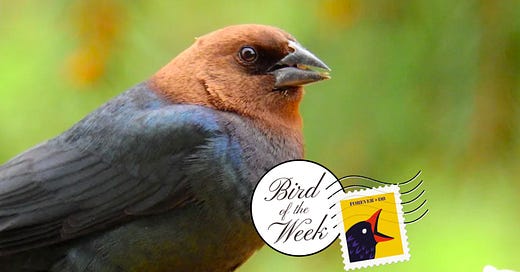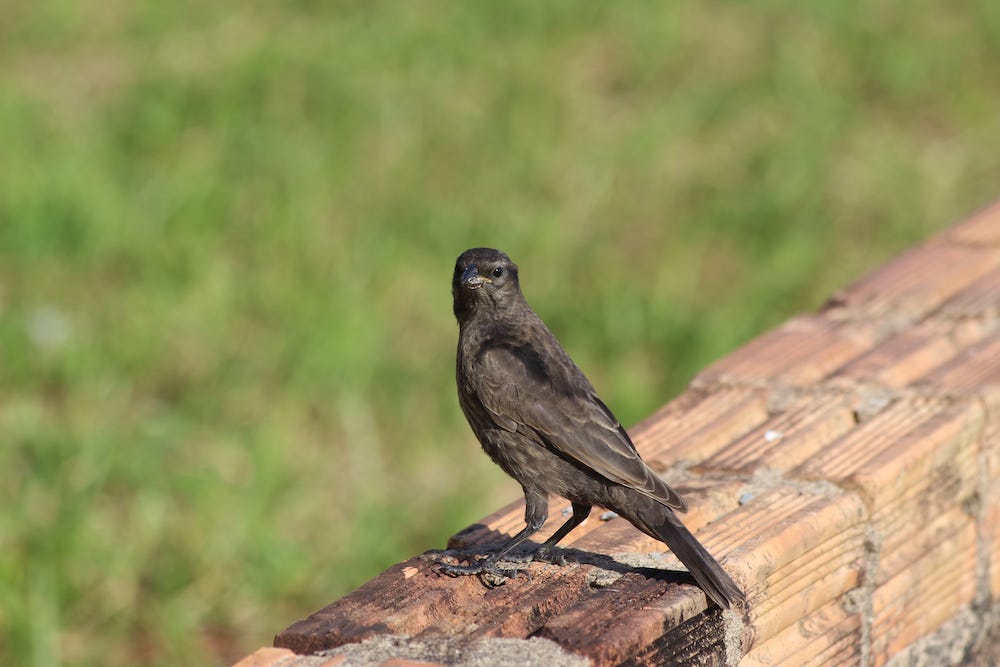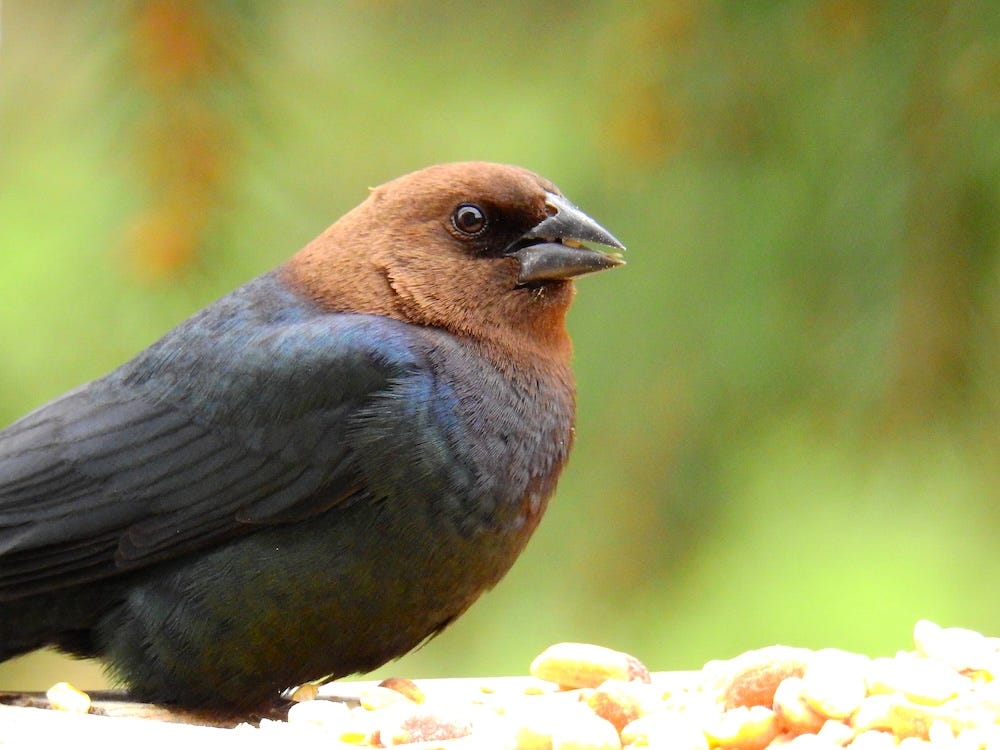
To hear this post read aloud, please click on the play button at the top of the blog.
A lot of the time on Bird of the Week, we go for birds that uplift, that spark joy, that prompt a sigh of contentment. There are big exceptions to this—looking at you, murderous psychopathic northern shrike—but generally, we feel like the world is bad enough without this feature adding to the dicey vibes.
Well, not today. By special reader request, we are focusing on a bird that taps into the dark side of existence—one whose whole method of survival is based on deception and outright thievery. If you would prefer not to take this journey with us, here’s your exit ramp. I’ll just give you a second to go find a nicer bird. Can I suggest our Bird of 2023, the great bustard? Have fun!
(Waiting, waiting.)
OK, the scaredy-cats are gone. Now let’s talk about….the cowbird.
So yeah, the name does not exactly send a chill down the spine. According to the Smithsonian Zoo, cowbirds are called cowbirds because of their “habit of following herds of buffalo (and cattle) in search of the insect prey that [was] flushed up by the large grazing mammals.” Seems pretty benign. And if you looked at the various varieties of cowbird with no prior knowledge—there are five species, by the way, and you can find at least one of them in most of the Americas—you probably wouldn’t say “Wow, there goes one of birddom’s biggest villains.”
OK, maybe the big beady red eye that some of the birds have would cause some jitters. But overall, they look pleasant enough!
Pleasant, however, cowbirds are most certainly not. That’s because they are one of the most prominent examples in the bird world of something called brood parasitism. Yes, it’s as creepy as it sounds! Let’s turn it over to the bird site with the unfortunate name for more (emphasis mine):
Of all the birds in the world, none may be as clever and cruel as brood parasites. These opportunistic animals dump their eggs into another species’ nest to avoid wasting time and energy on childcare (some female parasites literally have a larger memory complex in their brain to help them remember and hone in on targets). Their life strategy is built on tricking other birds, so perhaps they’ve earned the nasty reputation that precedes them—some parasites’ very first act upon hatching is to kill their adopted “siblings.” This is survival of the fittest at its most ruthless, and with about 100 parasitic bird species out there, it seems to be working.
Yiiiiiiiiiiiiiiiiiiiiiiiiiiiiikes. The Smithsonian Zoo says that cowbirds are “proof that one bad apple can spoil the whole bunch,” and two scholars writing for the American Ornithological Society went out of their way to note, “we confess that we still dislike Brown-headed Cowbirds.” Do you know how shady you have to be as an animal for people whose whole deal is animals to talk that kind of trash about you???
The cowbirds do get some points for not being one of the species that kills all the other chicks in the nest—unlike another big brood parasite, the common cuckoo. Yep, it has all of that time to work with clocks because it conned other birds into raising its kids and then those kids murdered all the other kids!
Cowbirds are technically known as “obligate brood parasites.” This is a particularly hardcore version of the whole thing, because obligate brood parasites literally do not even know how to build nests. Every single cowbird had its parent drop its egg into another bird’s nest and bounce. Then it was raised by a whole other kind of bird. It’s wild! And they are incredibly devious about this, as the Badgerland Bird Alliance in Madison describes:
Female cowbirds search for nests to slip their eggs into. Then they must watch nests carefully, and time their mating & egg laying perfectly-- all so the host species parents will be more likely to accept their egg. They often remove a host species egg while at the nest, so the number of eggs remains the same. Cowbirds can lay about 40 eggs during a nesting season, though the record is 70. They also lay eggs 10 times faster than most birds, allowing them to get in and out of a host nest before the parents return.
Here’s a little video showing a cowbird laying an egg in another nest. Watch for the number of eggs at the beginning versus the end.
There are real consequences for this. For instance, cowbirds usually take less time to hatch than other birds, so by the time the other chicks are hatched, there’s this much bigger bird already hanging around and hogging the food and the attention. The mother can’t differentiate between the chicks, so the littler ones just have to deal, or, y’know, die.
Sometimes the baby cowbird is larger than its forcibly adopted parent!
Not all birds fall for this. Robins, for example, have gotten wise to invader eggs in their nests and they are brutal in response. They just throw the eggs right out.
OK, for this next part, I have a warning: if you live in Michigan—and specifically, if you are Discourse Blog icon and Michigan Journalism Hall of Fame inductee John Schneider—you might want to brace yourself.
That’s because the Kirtland’s Warbler—the very first bird featured in the Bird of the Week, and Mr. Schneider’s candidate for Michigan state bird—was nearly driven to extinction by, you guessed it, the cowbird. Here’s the Smithsonian again:
Kirtland’s warblers became dependent on conservation efforts in Michigan, which is where their summer nesting grounds are, in 1972. Although cowbirds are a native species to North America, they had not lived in Michigan before the early 1900s. By 1971, only 200 male Kirtland’s warblers remained in the wild and about 70% of their nests were parasitized by cowbirds.
Luckily, the warbler’s numbers have rebounded somewhat, and human intervention is no longer needed to protect them—but still!
OK, we’re over 1000 words on this blog so I have to wrap things up. I’ll leave with these thoughts. Sometimes animals are fuzzy and adorable, and sometimes they are not. Evolution doesn’t care! All that natural selection is doing is perpetuating the species by hook or by crook. Cowbirds go about this in a decidedly unpleasant way, but there is an evil genius in their method. There is something darkly impressive about how they have managed to con the rest of the bird world into helping them carry on. They’re not using brute force or tyranny. They’re just being huge scammers, and have been getting away with it for eons. And for that, you almost have to hand it to them. The world needs its villains as well as its heroes, and as far as that goes, cowbirds are at the top of the charts.
A reminder: you can check out our complete Bird of the Week list here, and get in touch with your bird suggestions at hello@discourseblog.com.























Are we sure Reagan didn’t get his inspiration for welfare queens from cowbirds? Cuz these dirtbags kinda fit the bill. Although they are still not so monstrous as the demonic cuckoo.